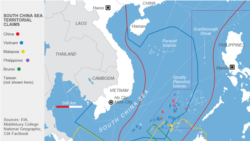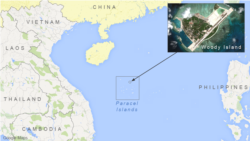Regional experts say U.S. officials are using a range of aircraft to make speedy yet thorough checks on China’s expansion in a disputed Asian sea.
The flights, added to the more obvious passages of navy ships through the South China Sea, will further inflame China, analysts say, adding that planes see more than ships and complete their missions faster.
Aircraft can handily survey the sea and due to their altitude see “a lot of things a vessel cannot” from a “bird’s eye” view, said Alexander Vuving, a professor at the Daniel K. Inouye Asia-Pacific Center for Security Studies in Hawaii. Planes come and go faster than ships, he added. U.S. warship passages into the South China Sea doubled in 2019.
The American planes fly more than 22 kilometers from China’s shoreline, Vuving said.
“Whether it’s intensifying or not is already accepted, even already included, in China’s strategic calculations,” said Eduardo Araral, associate professor at the National University of Singapore's public policy school.
Range of aircraft
Among the more visible U.S. aircraft are B-52 bombers, which were sighted in 2018 and in July last year when they flew from Guam to join an aircraft carrier exercise. Last month planes took off from U.S. aircraft carrier strike groups that were moving through the sea.
Washington regularly sends reconnaissance aircraft to the South China Sea, Chinese sources say. From March to November last year, the U.S. sent three civilian contractor surveillance aircraft to “monitor” the South China Sea among other waterways, the Chinese government-backed research website South China Sea Strategic Situation Probing Initiative says. The civilian planes are backing up eight types of military reconnaissance aircraft, the database says. The U.S. military sent “strategic bombers” to the South China Sea last year, it adds.
Reconnaissance aircraft flew over the South China Sea three times in February, Beijing’s state-monitored Global Times reported. The U.S. Indo-Pacific Command did not answer a request for comment.
In 2019, the U.S. Marines Corps sent its F-35B Lightning II aircraft for joint military exercises in the Philippines, marking an increase in military capability “committed to a free and open Indo-Pacific region”, the U.S. Navy says on its website.
Chinese reaction
Airspace outside a 22 kilometers normally belongs to no single country, but Beijing claims 90% of the South China Sea and cites historical records that indicate Chinese use of the waterway.
Brunei, Malaysia, the Philippines, Taiwan and Vietnam call all or parts of the same 3.5 million-square-kilometer sea their own, causing friction with China. Claimant states look to the warm waters for fish and undersea fuel reserves.
The Chinese research website calls U.S. reconnaissance operations “frequent” and says they have “built up strong momentum for battlefield construction and warfighting readiness across the U.S. military.” Officials in Beijing say U.S. military units disrupt peace and violate international law.
The United States, China’s former Cold War rival and modern-day superpower rival, makes no claim to the sea. It has stepped in as Beijing takes a military lead in the maritime dispute, threatening a network of pro-U.S. governments such as Taiwan and the Philippines.
China, which is backed by a growing military that ranks as the world’s third strongest, would take “strong steps” if an American plane entered its air space, Araral said. Chinese planes and warships already hold periodic drills in the contested sea.
Both powers will probably keep flying until two-way relations improve, said Alexander Huang, strategic studies professor at Taiwan’s Tamkang University. The two countries stand at odds over trade and technology as well as China’s military pressure against its neighbors.
“The real thing is that if the United States-China mil-mil [military ties] is not going back to normal, then we will continue to see this kind of reports (and) complaints,” Huang said.
Welcomed outside China
The five other South China Sea claimants look to Washington for support against Beijing’s maritime expansion as they’re all militarily weaker than China. They resent China’s land reclamation on some of the sea’s tiny islets as well as the circulation of Chinese ships near sensitive natural gas and oil reserves. Military infrastructure occupies some Chinese-held islets today, and Chinese fighter jets have been spotted as recently as July on Woody Island — a feature vigorously contested by Vietnam.
Southeast Asian claimants hope the U.S. flights will deter China from extending its maritime claims, analysts believe.
For the Philippines, “when the U.S. does these things, it in a sense demonstrates some sort of a balance of power,” said Aaron Rabena, a research fellow at the Asia-Pacific Pathways to Progress Foundation in the Philippines’ Quezon City.









